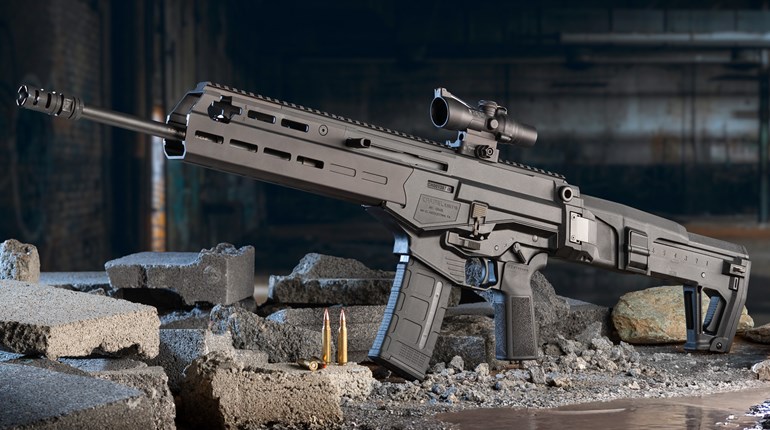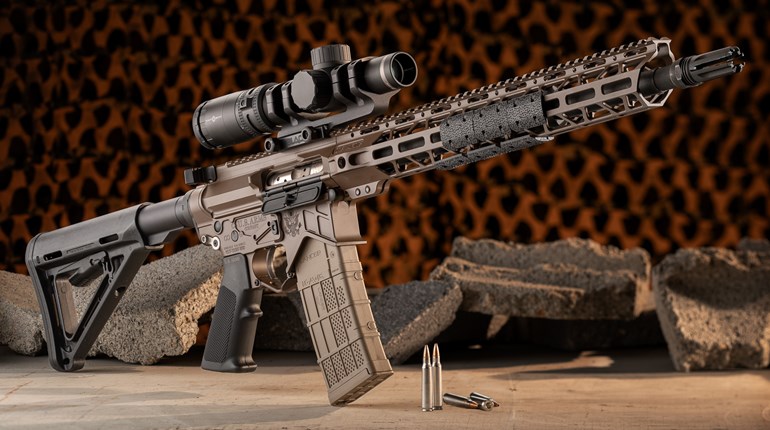
The Ruger Mini-14 has proven its ruggedness since it started riding around in pickups in 1974, but getting it to consistently shoot neat little groups at 100 yards has often been an exercise in frustration. Accuracy—frankly not the Mini-14's strongpoint—has generally taken a backseat to its simple and reliable operation. With competitive action-shooting events on the rise, Ruger decided to address this issue, introducing the Mini-14 Target Rifle accompanied by claims of minute-of-angle performance.
Appropriate for a Mini-14 derivative, the Target Rifle keeps the fixed-piston gas system and rotary bolt with dual locking lugs borrowed from the M1 Garand and the line's military inspiration, the M14. The investment-cast receiver and L-shaped charging handle have a matte-stainless finish. Scope bases integral to the receiver—a feature that debuted on the Mini-14 Ranch Rifle during the early 1980s—also fittingly appear on the Target Rifle. Ruger includes high, 1-inch rings for mounting an optic, which is mandatory since the receiver and barrel are devoid of iron sights. Other features manifest in the Mini-14 family and carried on with the Target Rifle are a Garand-style safety, stout magazine release lever and ventilated, fiberglass handguard that covers the barrel from receiver to gas block.
The similarities end there.
Ruger started its Mini-14 makeover by going straight for what most often is the deciding factor in a rifle's accuracy—the barrel. Though the lightweight, 18 1⁄2-inch barrel of the standard Ranch Rifle makes for quick and easy handling, it has many times bore the brunt of the criticism stemming from inaccuracy. The Target Rifle, in contrast, has a heavy, hammer-forged, stainless steel barrel that is .78 inch in diameter where it emerges from the gas block, with an additional 3 1⁄2 inches of length. Its six-groove rifling has a 1:9 RH twist to stabilize all but the heaviest .224-caliber match bullets.
Prominent on the barrel is a 41⁄2-inch-long, harmonic-dampening weight. The 3⁄16-inch-thick sleeve slips over the barrel, and four Allen-head screws keep it in place. A series of helical grooves on the barrel's surface allow the position of the harmonic dampener to be changed by turning it after loosening the attachment screws. Rotating the harmonic dampener clockwise moves it toward the receiver, while turning it counterclockwise shifts it toward the muzzle.
Barrel harmonics, or the vibration of the barrel during firing, can greatly affect point of impact and group size. Functions that occur within a rifle such as the firing pin striking the primer, the ignition of the propellant, the expansion of the propellant gases and the bullet's contact with the rifling as it travels through the bore all produce a number of vibrations that are ultimately transmitted to the barrel. These vibrations cause the barrel to move in an arc, even before the bullet has exited the bore. If these vibrations were absolutely consistent, there would be a lot of rifles shooting one-hole groups. However, their magnitude and duration vary from shot to shot, and five bullets may leave the bore when the muzzle is at five different points on the vibration-induced arc. In part, this is why even a very tight group will still somewhat resemble a triangle.
One way to control vibration is to add weight to the barrel, which soaks up the impulses. The heavy barrel on the Target Rifle works together with the harmonic dampener to reduce the amplitude of the arc, making bullet exit, and therefore point of impact downrange, more consistent. Different loads, of course, can produce different amounts of vibration, and the ability to adjust the harmonic dampener allows the shooter to tune the barrel to obtain the best accuracy with any given ammunition.
A beefy barrel does not a target rifle make, so Ruger continued overhauling the Mini-14 by giving it a stock eminently suited for shooting from the bench. The thumbhole buttstock has a large, triangular-shaped cutout just behind the pistol grip that not only lets the thumb encircle the pistol grip, but also provides a stable shelf on which its fleshy base can rest. Along with the slight swell to the pistol grip, the design promotes a steady, repeatable hold. The stock's high, slim comb rises slightly at the heel and digs into the cheek for a tight weld. So it will nestle solidly into a sandbag, the toe is rather thin and parallels the comb for 3 inches. The stock's lower line then curves dramatically upward before running forward to the pistol grip, forming a hook for the non-shooting hand to press against and keep the rifle firmly settled on the bench. Three removable, black plastic spacers just forward of the rubber buttpad let shooters adjust the stock's length of pull from 14 to 15 1⁄2 inches in 1⁄2-inch increments. In keeping with the theme of the Target Rifle, Ruger gave the fore-end a 2-inch-wide flat spot to make it easy to rest the gun on sandbags or hold in an offhand position. The stock is constructed of a gray laminate that complements both the stainless finish of the rifle's metal and the black handguard.
A Mini-14 that will shoot minute of angle? I, too, was skeptical. But to give the Target Rifle a fair chance, I topped it with a Sightron SII Big Sky 4.5-14x42 mm scope and waited for a calm day to test Ruger's claim. I picked the 55-grain soft-point load from Black Hills to start. The first several groups from the 100-yard line were around 2 1⁄2 inches—pretty much what I expected from a Mini-14 and certainly nothing to write home about. Then I began playing with the position of the harmonic dampener and shot as many holes in the criticisms of this autoloader's accuracy as I did targets. With this particular load, the rifle liked the forward end of the harmonic dampener to be positioned about 3⁄4 inch behind the muzzle. Thusly tuned, it produced five, five-shot groups that averaged 1.03 inches. Pretty dang close, and two of those groups measured inside the minute-of-angle standard. I tried several other loads, including some with match bullets weighing between 69 and 75 grains, but none of them delivered the accuracy of my first pick. The runner-up was the 50-grain Winchester Supreme Ballistic Silvertip load, which averaged 1.10 inches after 25 shots. Perhaps with a little more tweaking I could find the harmonic dampener's sweet spot with these other loads and shave a little from their group sizes.
True to the nature of the Mini-14, I experienced no failures to feed or fire during testing, and that was during approximately 400 rounds of 12 ammunition types over three days. No complaints there, but I did have an issue with the Target Rifle's trigger. At 5 1⁄2 pounds of pull weight, it's quite heavy for a rifle intended for target work, and I had to squeeze through a lengthy amount of creep. Nonetheless, I learned to live with it, and from the factory the Target Rifle performed as advertised.
The Mini-14 is rarely described as being pinpoint accurate, and in fact, until now it was never made to be. With some modifications, Ruger has turned this ubiquitous truck gun into a rifle ideally suited for chewing out bullseyes. I'd call the Mini-14 Target Rifle accurate any day.





































